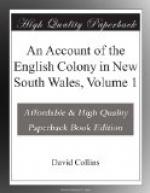At noon on the 4th preparations were made on board the Sirius for falling in with the land; her cables were bent, signal-guns prepared, and every possible precautions taken to ensure the safety of the fleet.
About ten at night on the 5th, a very beautiful aurora australis was observed bearing about south-west of the fleet; and for some nights a luminous phenomenon had been seen resembling lights floating on the surface of the water.
By a lunar observation taken at ten o’clock of the forenoon of Monday the 7th, the fleet was then distant seventeen leagues from the South Cape of New Holland; and at five minutes past two in the afternoon the signal was made for seeing the land. The rocks named the Mewstone and Swilly were soon visible, and the fleet stood along shore with fair moderate weather and smooth water, the land of New Holland distant from three to five miles.
Nothing could more strongly prove the excellence and utility of lunar observations, than the accuracy with which we made the land in this long voyage from the Cape of Good Hope, there not being a league difference between our expectation of seeing it, and the real appearance of it.
A thick haze hanging over the land, few observations could be made of it. What we first saw was the South-west Cape of New Holland, between which and the South Cape the land appeared high and rocky, rising gradually from the shore, and wearing in many places a very barren aspect. In small cavities, on the summit of some of the high land, was the appearance of snow. Over the South Cape the land seemed covered with wood; the trees stood thick, and the bark of them appeared in general to have a whitish cast. The coast seemed very irregular, projecting into low points forming creeks and bays, some of which seemed to be deep; very little verdure was any where discernible; in many spots the ground looked arid and sterile. At night we perceived several fires lighted on the coast, at many of which, no doubt, were some of the native inhabitants, to whom it was probable our novel appearance must have afforded matter of curiosity and wonder.
In all the preceding passage we had been scarcely a day without seeing birds of different kinds; and we also met with many whales. The weather was in general very rough, and the sea high, but the wind favourable, blowing mostly from north-west to south-west.
The convoy behaved well, paying more attention and obedience to signals than ships in the merchant service are commonly known to do. The ships, however, began to grow foul, not one of them being coppered, and we now anxiously wished for a termination of the voyage, particularly as the hay provided for the horses was on the point of being wholly expended.
The fair wind which had accompanied us to New Holland suddenly left us, shifting round to north-east and by east; we were obliged to lay our heads off-shore, in order to weather Swilly and the Eddystone (a perpendicular rock about a league to the eastward of Swilly) and the next day we had the mortification of a foul wind, a thing to which we had been long unaccustomed.




